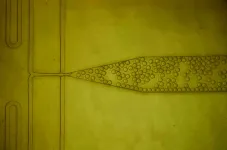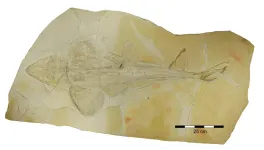(Press-News.org) Research by a team that includes two faculty members from the University of Colorado School of Medicine may change the treatment paradigm for patients with eosinophilic esophagitis (EoE), an allergic condition that causes chronic inflammation in the esophagus that can lead to esophageal narrowing and dysfunction.
Glenn Furuta, MD, professor of pediatric gastroenterology, hepatology, and nutrition, and Paul Menard-Katcher, MD, associate professor of gastroenterology, helped lead the National Institutes of Health (NIH)-funded, multisite study that shows that a single-food elimination diet — one in which dairy products are eliminated — is just as effective as the standard six-food elimination diet for achieving remission in eosinophilic esophagitis. The paper was published today in Lancet Gastroenterology and Hepatology.
“Eosinophilic esophagitis is a chronic disease that affects children and adults,” Furuta says. “It causes significant problems with eating dysfunction in young children, and in adults it causes problems with food getting stuck and food impactions, as well as problems with swallowing. EoE is classically thought of as an allergic disease sparked by food allergens, so there’s a lot of interest in trying to remove foods from the diet to treat it.”
The problem with that approach, Furuta says, is that there is no test to easily identify which food allergen causes EoE in any given patient. Gastroenterologists typically start treatment by removing the six most common food allergens — dairy, wheat, eggs, soy, fish/shellfish, and peanuts/tree nuts — then reintroducing them one by one to see which sparks the inflammation. It’s an approach that necessitates multiple endoscopies to pinpoint the precise cause of EoE, and one that presents a significant decrease in quality of life for patients who must severely limit their diet in addition to undergoing a series of invasive tests.
Looking for less-drastic options
Working with the Consortium of Eosinophilic Gastrointestinal eosinophiLic disease Researchers (CEGIR) led jointly by the CU School of Medicine and Cincinnati Children’s Hospital Medical Center, Furuta and Menard-Katcher began looking for a less-drastic dietary treatment option for EoE. Knowing that dairy is the most common allergen responsible for the disease, they constructed a clinical trial for adults ages 18 to 60 with active EoE. Half of the participants were assigned the standard six-food elimination diet for six weeks, and half eliminated only dairy products over the same timeframe.
At the end of the almost three-year trial, the researchers discovered that histological remission was statistically the same in both groups. Thirty-four percent of participants had remission from eliminating dairy alone, indicating that method as an acceptable initial dietary therapy for EoE.
“We started off by saying, ‘Do we have to have so many foods eliminated? Is it necessary to go all the way to removing the six foods, or can we just start with the most common allergen first, and then if that’s not effective, move up to the six-food elimination diet?’” says Furuta, who is working with other CEGIR researchers on a similar study in pediatric EoE patients. “It was taking a very practical approach to addressing a very concerning problem.”
Alternative to medications
Other treatments for EOE include proton pump inhibitors, topical steroids, and expensive biologic medications, all of which come with side effects. Dietary therapy is preferred, Menard-Katcher says, but eliminating six foods can be intimidating, especially for children. Working with patient-advocacy groups as well as the NIH, the researchers strived to create a patient-friendly trial that would result in an easier path toward remission for more patients.
“We have a lot of patients who would love to do dietary therapy, if that enables them to avoid the use of chronic medications,” Menard-Katcher says. “But the six-food elimination diet has a lot of drawbacks. You’re talking about eliminating a lot of foods that people eat really commonly. Then you add to that the burden of repeated endoscopies to try and identify the trigger or triggers, knowing that you also might not identify those triggers. It’s much easier for a patient to hear that they might have to try eliminating dairy as a first-line therapy rather than dairy, wheat, eggs, soy, tree nuts, and seafood.”
Strength in gastrointestinal research
The new study not only is a boon for patients with EoE and the physicians who treat them; it’s also evidence of the strengths in research and treatment for EoE and similar gastrointestinal diseases on the CU Anschutz Medical Campus. That includes the Gastrointestinal Eosinophilic Diseases Program at Children’s Hospital Colorado, a multidisciplinary program that currently sees patients from around 40 states who travel to the clinic for research studies and multidisciplinary care.
“We feel very fortunate because just across campus, Dr. Menard-Katcher and his team are there on the adult side for us to transition our local patients to,” says Furuta, director of the Gastrointestinal Eosinophilic Diseases Program and section head of the Digestive Health Institute at Children’s Colorado. “Institutionally, on this campus, we have a fantastic team that is helping to shape the field.”
END
CU School of Medicine researchers part of national team that identified a new dietary approach to treatment for eosinophilic esophagitis
The research published in Lancet Gastroenterology and Hepatology shows that eliminating dairy alone is as effective as the six-food elimination diet that is standard for the condition.
2023-02-28
ELSE PRESS RELEASES FROM THIS DATE:
New purification method could make protein drugs cheaper
2023-02-28
CAMBRIDGE, MA -- One of the most expensive steps in manufacturing protein drugs such as antibodies or insulin is the purification step: isolating the protein from the bioreactor used to produce it. This step can account for up to half of the total cost of manufacturing a protein.
In an effort to help reduce those costs, MIT engineers have devised a new way to perform this kind of purification. Their approach, which uses specialized nanoparticles to rapidly crystallize proteins, could help to make protein drugs more affordable and accessible, especially in developing ...
Graphene Flagship spin-off company INBRAIN Neuroelectronics wins prestigious innovation award
2023-02-28
INBRAIN Neuroelectronics, a Graphene Flagship spin-off company, has been named Spain’s most innovative company by leading Spanish news publication El Periódico.
INBRAIN exists to decode and modulate neural networks to improve patients’ lives. More specifically, INBRAIN is harnessing the unique properties of graphene to develop high density and high-resolution brain interfaces coupled to an intelligent system with high signal processing power to provide breakthrough neuroelectronic therapies.
The company was founded in 2020 by researchers from Graphene Flagship partner the Catalan Institute of Nanoscience ...
Henry Ford Medical Group appoints Dr. Brien J. Smith to top neurology role
2023-02-28
DETROIT (February 28, 2023) – The Henry Ford Medical Group today announced Brien J. Smith, M.D., MBA, a national expert in neurology and epilepsy, as its new Chair of the Department of Neurology.
In this leadership role, Dr. Smith will oversee all clinical, research and administrative services for the Department of Neurology at Henry Ford Health. A veteran of Henry Ford, Dr. Smith was previously part of Henry Ford Hospital’s Neurology Department for 18 years, serving as Director of the Epilepsy Monitoring Unit, Medical Director of the Comprehensive Epilepsy Program, and Director of the Clinical Neurophysiology Program at Henry Ford Hospital in Detroit. He ...
Responsive ankle exoskeleton algorithm handles changes in pace and gait
2023-02-28
Images
Ankle exoskeletons that can help people extend their endurance are a step closer to reality with a new control algorithm, developed at the University of Michigan, that could enable future exoskeletons to automatically adapt to individual users and tasks. This would reduce or eliminate the need for manual recalibration.
Current exoskeletons are limited because they must be tailored to a single user performing a single task, like walking in a straight line. Any changes require a lengthy set ...
Obesity makes it harder to diagnose and treat heart disease
2023-02-28
ROCHESTER, Minn. — Being overweight impacts your heart health in more ways than you might think. A new JACC review paper from Mayo Clinic outlines how obesity affects the common tests used to diagnose heart disease and impacts treatments. Cardiovascular disease is the leading cause of death in the U.S. and globally, yet it is largely preventable.
"Excess fat acts as a kind of filter and can skew test readings to under-or overdiagnosis," says senior author Francisco Lopez-Jimenez, M.D., director of preventive cardiology at Mayo Clinic. "Obesity affects ...
Shirley Ryan AbilityLab receives department of defense grant for first-of-its-kind study on neurally controlled bionic legs with osseointegration
2023-02-28
CHICAGO — Feb. 28, 2023 — Today, millions of individuals across the world live with limb loss, including thousands of combat-injured service men and women. Although significant progress has been made in the durability, control and function of prosthetic devices, they lack complete integration into the body.
Now, with the award of a $1.5 million grant from the Department of Defense Congressionally Directed Medical Research Program (CDMRP), Shirley Ryan AbilityLab — the top-ranked physical medicine and rehabilitation hospital — ...
BU researchers receive $1.3m EPA grant to advance climate resilience among Mystic River communities
2023-02-28
FOR IMMEDIATE RELEASE
February 28, 2023
Contact:
Jillian McKoy, jpmckoy@bu.edu
Michael Saunders, msaunder@bu.edu
##
BU Researchers Receive $1.3M EPA Grant to Advance Climate Resilience among Mystic River Communities
The three-year project aims to identify and address the cumulative impacts of chemical hazards and climate change that affect the 21 communities surrounding the Mystic River Watershed.
The 21 communities that surround Greater Boston’s Mystic River Watershed are exposed to many of the central threats of climate change, including urban heat islands and coastal and inland flooding, while also confronting multiple chemical exposures.
Now, with ...
Artificial intelligence with a human touch
2023-02-28
Despite the remarkable progress in artificial intelligence (AI), several studies show that AI systems do not improve radiologists' diagnostic performance. In fact, diagnostic errors contribute to 40,000 - 80,000 deaths annually in U.S. hospitals. This lapse creates a pressing need: Build next-generation computer-aided diagnosis algorithms that are more interactive to fully realize the benefits of AI in improving medical diagnosis.
That’s just what Hien Van Nguyen, University of Houston associate professor of electrical and computer engineering, is doing with a new $933,812 grant from the National Cancer Institute. He will focus on ...
Compression treatment could relieve horses’ painful swollen limbs
2023-02-28
Researchers from North Carolina State University have taken technology aimed at helping humans suffering from lymphedema – in which the accumulation of excess lymph fluid causes swollen limbs – and developed a medical device to aid horses suffering from the same condition. In a pilot study the device, called the EQ Press, was successful in moving fluid up the limbs and into the lymph nodes. This could lead to relief for horses with chronic conditions, as well as with temporary swelling due to injury or inactivity.
“Across the board, ...
Jurassic shark – Shark from the Jurassic period was already highly evolved
2023-02-28
Cartilaginous fish have changed much more in the course of their evolutionary history than previously believed. Evidence for this thesis has been provided by new fossils of a ray-like shark, Protospinax annectans, which demonstrate that sharks were already highly evolved in the Late Jurassic. This is the result of a recent study by an international research group led by palaeobiologist Patrick L. Jambura from the Department of Palaeontology at the University of Vienna, which was recently published in the journal Diversity.
Cartilaginous fishes (sharks, rays, and ratfish) ...
LAST 30 PRESS RELEASES:
Making lighter work of calculating fluid and heat flow
Normalizing blood sugar can halve heart attack risk
Lowering blood sugar cuts heart attack risk in people with prediabetes
Study links genetic variants to risk of blinding eye disease in premature infants
Non-opioid ‘pain sponge’ therapy halts cartilage degeneration and relieves chronic pain
AI can pick up cultural values by mimicking how kids learn
China’s ecological redlines offer fast track to 30 x 30 global conservation goal
Invisible indoor threats: emerging household contaminants and their growing risks to human health
Adding antibody treatment to chemo boosts outcomes for children with rare cancer
Germline pathogenic variants among women without a history of breast cancer
Tanning beds triple melanoma risk, potentially causing broad DNA damage
Unique bond identified as key to viral infection speed
Indoor tanning makes youthful skin much older on a genetic level
Mouse model sheds new light on the causes and potential solutions to human GI problems linked to muscular dystrophy
The Journal of Nuclear Medicine ahead-of-print tip sheet: December 12, 2025
Smarter tools for peering into the microscopic world
Applications open for funding to conduct research in the Kinsey Institute archives
Global measure underestimates the severity of food insecurity
Child survivors of critical illness are missing out on timely follow up care
Risk-based vs annual breast cancer screening / the WISDOM randomized clinical trial
University of Toronto launches Electric Vehicle Innovation Ontario to accelerate advanced EV technologies and build Canada’s innovation advantage
Early relapse predicts poor outcomes in aggressive blood cancer
American College of Lifestyle Medicine applauds two CMS models aligned with lifestyle medicine practice and reimbursement
Clinical trial finds cannabis use not a barrier to quitting nicotine vaping
Supplemental nutrition assistance program policies and food insecurity
Switching immune cells to “night mode” could limit damage after a heart attack, study suggests
URI-based Global RIghts Project report spotlights continued troubling trends in worldwide inhumane treatment
Neutrophils are less aggressive at night, explaining why nighttime heart attacks cause less damage than daytime events
Menopausal hormone therapy may not pose breast cancer risk for women with BRCA mutations
Mobile health tool may improve quality of life for adolescent and young adult breast cancer survivors
[Press-News.org] CU School of Medicine researchers part of national team that identified a new dietary approach to treatment for eosinophilic esophagitisThe research published in Lancet Gastroenterology and Hepatology shows that eliminating dairy alone is as effective as the six-food elimination diet that is standard for the condition.





